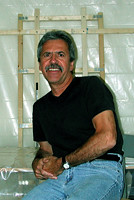Etude#1 for Bass Clarinet: Vertical Luz
of light
passes through
her height
as wind
from the movement
of my fingers
gift sound
to the world
of my fantasies.
As
each touch
finds entrance
to an opening
of pleasure,
sound
of
the instruments
delight
moans
from
embouchure
to
bell,
defining
length
as well.



7 Comments:
This poem is a perfect wedding between music and art, inspiration and instrument, muse and artist, the woman of love, that he loves, and his expression in poetry that is music... very beautiful.
Coleridge believed that every one of us is an Aeolian harp -- a wind harp -- producing our individual sounds in response to a divine wind or breath. In turn, the sounds that arise from us give order to all of perceived nature.
"And what if all animated nature
Be but harps diversely fram'd,
That tremble into thought, as o'er them sweeps
Plastic and vast, one intellectual breeze,
At once the Soul of each, and God of all?"
--"The Eolian Harp," ll. 44-48
Brenda: Thank you for the sensitivity you bring to the reading of my newest attempt to come to terms with my muse. It's been an ongoing struggle and sometimes feels very lonely. My muse can be very silent and I often meet the sounds of her silence with attempts such as this. Again, your reading is greatly appreciated.
Richard: You always bring so much thoughtfulness and poetry to your insights. The rendering of Coleridge's "Eolian Harp" in the context of what I am trying to come to terms with in my "poem" is so much more beautiful than I could ever hope to attain. But it is exposure to empathy and compassion like yours that gives me the faith to keep moving forward.
I’ve often thought of my physical presence in the world akin to a body totally stripped of its skin with all its nerves exposed to the fiat of the wind. I’ve never heard of “Eolian Harp” till now. It is such a moving and wonderful expression of nature, of which I have always sensed my muse to have sprung from; but in the form of “light.” And she has a name…it is Luz!
Thanks again hermano!
Your vision of being flayed and exposed is one I would never have come up with, but I can see it now that you express it. Coleridge would like it. I've been reading him lately -- a deep spirit, a lot more than "Kubla Khan" and "The Ancient Mariner." The best way to get to know him is through Richard Holmes' two-volume biography.
Richard: I will look into the Coleridge writings you suggest.
I've felt the image of the nerves of the body exposed to the wind many times. Primarily as a way of coming to understand how necessary ( to me at least) it is to be open to all that nature provides; whether it be conducive to one's wishes or not; to live the moment at as it is carried through time, embellished by the unknown. I could go on with the many ways that I sense the feeling but basically. that's it.
It's a sense of life that I cherish.
Thanks again for the info on Coleridge and for taking the time to comment.
Sueno!
It would be great to hear this poem backed by a jazz composition for the clarinet based on its rythms. How about it, Dan?
And Richard's comment reminds me also of the music of the spheres (Johannes Kepler, "The Harmony of the Universe"). There's a fascinating book on all this I'm sure you'd like by Jamie James: "The Music of the Spheres" (Abacus paperback).
Actually. I'ts inspired a new painting. But surely I could compose a musical piece for it as well. That coupled with the eight large-scale paintings I have to complete for my Chicago commission ( which I will be reposting soon) should take me well into 2010!
Then...there's the Blog.
Yet...why not! I'll give it a try.
Hey I know the James book very well. I agree. A great read and certainly fills in well with what's on post.
Thanks Natalie.
I miss my muse....sigh. She's gotten very silent again. But she keeps promising....honest!
Post a Comment
<< Home